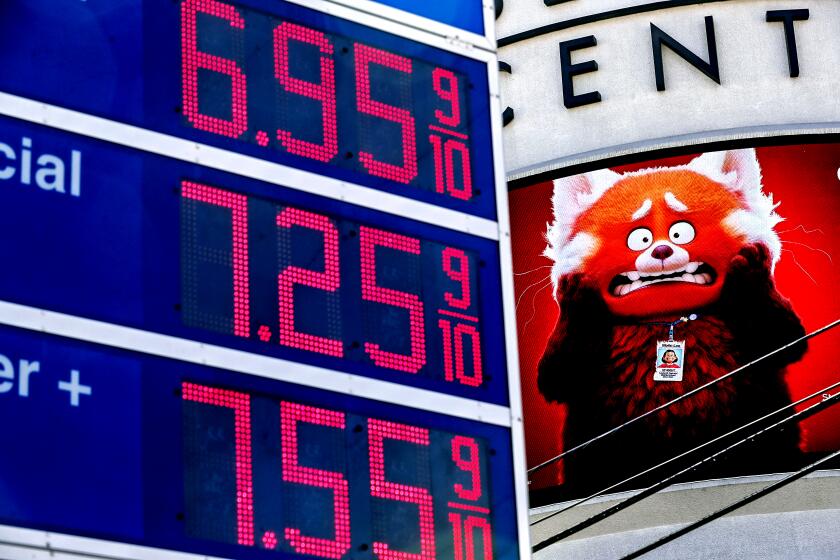Stocks jump most since June 2020 as oil prices fall sharply

- Share via
Stocks rallied for their biggest gain in nearly two years Wednesday as a sharp drop in oil prices eased fears that inflation was about to get worse around the globe.
The Standard & Poor’s 500 climbed 2.6%, its biggest increase since June 2020. The Dow Jones industrial average rose 2%, and the Nasdaq composite jumped 3.6%. The gains snapped a four-day losing streak for the major indexes, though they remained on pace for weekly losses.
The market turnaround came as the price of U.S. crude oil dropped 12%, the most since November, bringing relief after a sharp run-up in crude prices since Russia invaded Ukraine. Brent crude, the international oil standard, fell 13.2%, its biggest decline in almost two years.
You’ve seen the signs advertising $6.95, $6.99 or even $7.05 for a gallon of regular unleaded. But who’s buying it, and why?
Big swings have been jerking markets around in recent weeks as investors grope to guess how much economic damage Russia’s invasion of Ukraine will do. The swings have struck not only day to day but also hour to hour, with some days seeing several big reversals.
The chaotic movements are likely to continue with uncertainty so high about the war in Ukraine and its ultimate economic fallout. The region is key to markets because it’s a major producer of oil, wheat and other commodities, whose prices have surged on worries about disruptions to supplies.
“It’s one day, so it’s hard to really draw any type of conclusions,” said Keith Buchanan, senior portfolio manager at Globalt Investments. “Markets had their backs against the wall, kind of expecting the worst.”
Crude oil prices tumbled, and the slide accelerated amid reports that the United Arab Emirates will urge fellow OPEC members to boost production and ease supply concerns. A barrel of U.S. crude oil settled at $108.70. Brent closed at $111.14.
Stocks once again moved in the opposite direction of oil prices Wednesday, with inflation such a dominant worry. Analysts said bargain hunters may be scooping up stocks after concerns about a slowing economy coupled with high inflation triggered their steep recent slide. Many of those buyers appear to be smaller-pocketed, “retail” investors trading on their phones and laptops. And often they’re buying shares that big professional investors are selling.
Last week saw record selling of U.S. stocks by hedge funds, strategist Jill Carey Hall wrote in a recent BofA Global Research report. Retail investors and institutional investors were net buyers.
The moves by retail investors may be a result of people worrying about missing out on any potential rebound. A “buy-the-dip” strategy, in which drops in stocks were seen mainly as opportunities to buy low, was very successful after the 2020 crash caused by the coronavirus. The S&P 500 kept climbing from that plummet without a 10% correction until just recently.
Switching to electric cars would slash emissions and deal a blow to Vladimir Putin.
Big recent moves for markets also show that prices already reflect a lot of pessimism, with crude oil prices up more than 45% so far in 2022. That may be why crude prices actually receded Tuesday after President Biden announced a U.S. ban on imports of Russian oil. A ban will mean disruptions to supplies, but oil traders may already have accounted for it when they briefly pushed the price of U.S. crude above $130 a day before the announcement.
Gold prices and a measure of nervousness among stock investors on Wall Street also eased.
All told, the benchmark S&P 500 rose 107.18 points to 4,277.88. The Dow advanced 653.61 points to 33,286.25, and the Nasdaq jumped 459.99 points to 13,255.55. The Russell 2000 index of smaller-company stocks rose 53.28 points, or 2.7%, to 2,016.29.
European stocks rallied even more than the U.S. market. Germany’s DAX jumped 7.9% and France’s CAC 40 rose 7.1%.
European nations face an even greater shock than the U.S. from rising energy prices because of Russia’s invasion of Ukraine. That could result in the European Union taking greater action to shore up its economy.
The result could be more stimulus and more caution from central banks on interest rate increases, said Stephen Dover, chief market strategist and head of Franklin Templeton Investment Institute: “Whereas the U.S. will have the wind in its face as stimulus falls, Europe may actually have the wind at its back.”
On Wall Street, the gains were broad-based, with nearly 85% of the stocks in the S&P 500 rising, led by technology companies. Some of the strongest moves came from airlines, travel companies and other stocks that bounced back from steep drops on worries about fuel costs and the economy.
Among Wednesday’s few decliners were oil-related companies, which lost momentum after big leaps this year on the back of rising crude prices. Halliburton fell 5.2%, though it’s still up 52% for 2022.
Such swings have been particularly wide in markets for commodities because Russia is the No. 2 oil exporter and the No. 3 supplier of nickel, which is used in electric car batteries, stainless steel and other products. Russia and Ukraine also are among the biggest global sellers of wheat.
Less than a week after removing Russia from its list of nations deemed a safe place to invest, Fitch Ratings cut its credit rating on the nation further into junk status and warned of an imminent default on sovereign debt.
Treasury yields climbed as an anticipated increase in interest rates by the Federal Reserve nears. The Fed’s policymaking committee is meeting next week, and the wide expectation is that it will vote to raise its benchmark short-term rate by a quarter of a percentage point. It would be the first such increase since 2018.
The Fed is facing a delicate and increasingly tough task as it moves to raise rates through 2022, which tends to slow the economy. The central bank wants to pull rates high enough to push down inflation, which is at its highest level in generations. But it doesn’t want to raise them so much that it causes a recession.
“There’s more uncertainty about what the Fed is going to do now than just a few weeks ago,” Dover said.
The yield on the 10-year Treasury rose to 1.94% from 1.86% late Tuesday.
Bitcoin rallied 8% after Biden signed an executive order on government oversight of cryptocurrency. Crypto players have increasingly been saying they welcome increased regulation, and they want to have a hand in shaping it.
Associated Press writer Joe McDonald contributed to this report.
More to Read
Inside the business of entertainment
The Wide Shot brings you news, analysis and insights on everything from streaming wars to production — and what it all means for the future.
You may occasionally receive promotional content from the Los Angeles Times.












